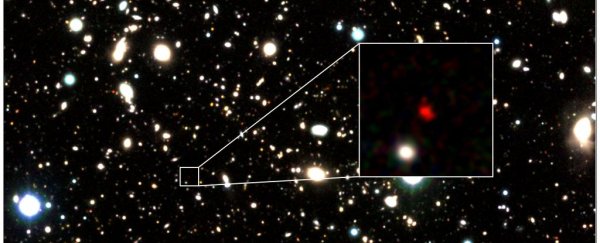A glowing red object in the early Universe has been identified as the most distant galaxy discovered to date.
It is, astronomers have revealed, a galaxy that existed just 330 million years after the Big Bang.
Its faint light, stretched by the expansion of the Universe, had to travel 13.5 billion light-years to reach us, here on Earth.
The discoverers have named the galaxy HD1, and it represents something of a mystery. Scientists are not entirely sure what the galaxy is: whether it's a starburst galaxy, positively roiling with star formation, or a quasar, with a massive, active supermassive black hole at its center.
If it's the latter, the black hole's growth to supermassive size so soon after the Universe winked into existence presents a challenge to models of black hole formation and evolution.
"Answering questions about the nature of a source so far away can be challenging," says astrophysicist Fabio Pacucci of the Harvard & Smithsonian Center for Astrophysics.
"It's like guessing the nationality of a ship from the flag it flies, while being faraway ashore, with the vessel in the middle of a gale and dense fog. One can maybe see some colors and shapes of the flag, but not in their entirety. It's ultimately a long game of analysis and exclusion of implausible scenarios."
Detecting objects from the early Universe is extremely difficult. Even quasars, the brightest objects in the whole cosmos, are dimmed across the vast reaches of space-time, to the point that our most powerful telescopes struggle to pick up their light.
HD1 was discovered as part of a survey to discover galaxies at the beginning of the Universe, the results of which are detailed in a paper accepted for publication in The Astrophysical Journal, and also available on arXiv.
An analysis of HD1 and a second galaxy named HD2, nearly as distant, has been accepted into the Monthly Notices of the Royal Astronomical Society, and it too is available on arXiv.
The survey employed four powerful optical and infrared telescopes: the Subaru Telescope, the VISTA Telescope, the UK Infrared Telescope,and the Spitzer Space Telescope. Between them, they racked up over 1,200 hours of observing time, peering into the Cosmic Dawn to search for light in the early Universe.
"It was very hard work to find HD1 out of more than 700,000 objects," says astronomer Yuichi Harikane of the University of Tokyo in Japan.
"HD1's red color matched the expected characteristics of a galaxy 13.5 billion light-years away surprisingly well, giving me a little bit of goosebumps when I found it."
The red color is known as redshift, and it occurs when a source of light is moving away from us. This causes the wavelength of the light coming from that source to increase towards the redder end of the electromagnetic spectrum, which is why it is called redshifting.
Because the Universe is expanding, other galaxies appear to be redshifted; the greater the distance away in space-time, the greater the redshift. This effect allows astronomers to calculate how far light has traveled to reach us.
But the light from HD1 is confusing. It's extremely bright in ultraviolet wavelengths, which suggests that a very energetic process was taking place within the galaxy. At first, the researchers thought it was normal starburst activity – until they calculated the number of stars that would have to be forming to produce that much light.
The number was incredibly high, over 100 stars a year. That's 10 times higher than expected for a galaxy in the early Universe. This tension could be resolved, however, if the stars being born were not the same as the stars we see being born today.
"The very first population of stars that formed in the Universe were more massive, more luminous and hotter than modern stars," Pacucci says.
"If we assume the stars produced in HD1 are these first, or Population III, stars, then its properties could be explained more easily. In fact, Population III stars are capable of producing more UV light than normal stars, which could clarify the extreme ultraviolet luminosity of HD1."
The other option is if the galaxy was a quasar. That's short for "quasi-stellar radio sources" – the incredibly bright result of an active galactic nucleus, with a supermassive black hole devouring material at such a rate that the heat generated blazes of light across the Universe.
To produce the observed light, the supermassive black hole would have to be around 100 million times the mass of the Sun, the team calculates.
That size seriously challenges supermassive black hole growth models. It's very chonky, very early in the Universe.
"Forming a few hundred million years after the Big Bang, a black hole in HD1 must have grown out of a massive seed at an unprecedented rate," says astrophysicist Avi Loeb of the Harvard and Smithsonian Center for Astrophysics.
"Once again, nature appears to be more imaginative than we are."
The team hopes that future observations with the James Webb Space Telescope, a machine optimized for peering into the early Universe, will reveal the nature of this mysterious dawn light.
The research has been accepted into The Astrophysical Journal and the Monthly Notices of the Royal Astronomical Society. The papers can be found on arXiv here and here.
